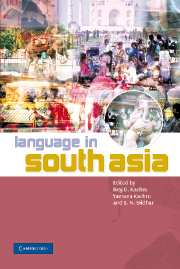Book contents
- Frontmatter
- Contents
- List of Figures
- List of Maps
- List of Tables
- Preface
- Acknowledgments
- List of Abbreviations
- Note on Transcription
- Introduction: languages, contexts, and constructs
- Part 1 Language history, families, and typology
- Part 2 Languages and their functions
- 3 Hindi–Urdu–Hindustani
- 4 Persian in South Asia
- 5 Major regional languages
- 6 Minority languages and their status
- 7 Tribal languages
- Part 3 Sanskrit and traditions of language study
- Part 4 Multilingualism, contact, and convergence
- Part 5 Orality, literacy, and writing systems
- Part 6 Language conflicts
- Part 7 Language and modernization
- Part 8 Language and discourse
- Part 9 Language and identity
- Part 10 Languages in diaspora
- References
- Subject Index
- Language Index
- Author Index
6 - Minority languages and their status
Published online by Cambridge University Press: 04 May 2010
- Frontmatter
- Contents
- List of Figures
- List of Maps
- List of Tables
- Preface
- Acknowledgments
- List of Abbreviations
- Note on Transcription
- Introduction: languages, contexts, and constructs
- Part 1 Language history, families, and typology
- Part 2 Languages and their functions
- 3 Hindi–Urdu–Hindustani
- 4 Persian in South Asia
- 5 Major regional languages
- 6 Minority languages and their status
- 7 Tribal languages
- Part 3 Sanskrit and traditions of language study
- Part 4 Multilingualism, contact, and convergence
- Part 5 Orality, literacy, and writing systems
- Part 6 Language conflicts
- Part 7 Language and modernization
- Part 8 Language and discourse
- Part 9 Language and identity
- Part 10 Languages in diaspora
- References
- Subject Index
- Language Index
- Author Index
Summary
This chapter discusses the minority languages in South Asia, exploring the implications of their status in terms of various sociolinguistic processes. Although the empirical scope of this chapter is restricted mainly to India and Pakistan, the generalizations presented here can be extended to other South Asian countries, such as Nepal, Sri Lanka, and Bangladesh.
Minority languages: contexts of definition
A numerical definition of the term minority languages renders all the languages spoken in India “minority,” since there is no language whose speakers constitute more than half of India's total population of roughly 1.1 billion. Hindi, the “official” language of India, has the highest number of speakers; yet they constitute less than 40 percent of the Indian population. Similarly, Urdu, one of the two official languages of Pakistan is spoken by less than 10 percent of the Pakistani population as a native language. In fact, according to the 2001 census, Urdu is the mother tongue of only 7.57 percent of the people in Pakistan (Census 2001: Table 2.7, cited in Rahman 2004: 2).
A sociological definition of the term, based on functional or ethnolinguistic vitality, turns “numerical” majority languages (at the state level) into minority languages. A good example of this is Kashmiri in the Indian state of Jammu and Kashmir. Although Kashmiri is spoken by a little over 53 percent of the total population of the state of Jammu and Kashmir, its functionality is severely restricted mainly to the home/family domains (Bhatt [Mohan] 1989; Kak 2001).
- Type
- Chapter
- Information
- Language in South Asia , pp. 132 - 152Publisher: Cambridge University PressPrint publication year: 2008
- 8
- Cited by

